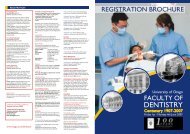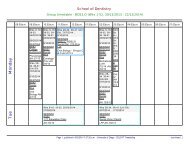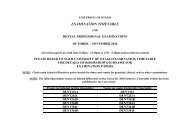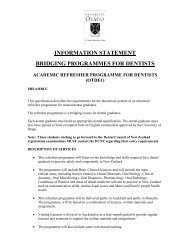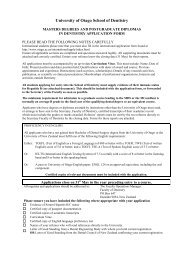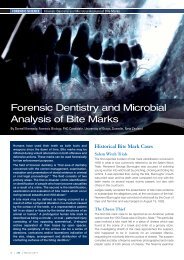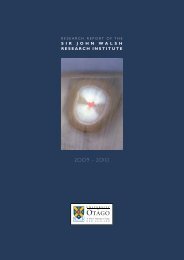Student Guest Speaker Student Presenters - Faculty of Dentistry ...
Student Guest Speaker Student Presenters - Faculty of Dentistry ...
Student Guest Speaker Student Presenters - Faculty of Dentistry ...
You also want an ePaper? Increase the reach of your titles
YUMPU automatically turns print PDFs into web optimized ePapers that Google loves.
1<strong>Student</strong> <strong>Guest</strong> <strong>Speaker</strong>Grace LeeFifth year dental student Grace Lee won first prize in the Hatton competition (JuniorCategory) at the 89th General Session <strong>of</strong> the International Association for DentalResearch (IADR) in San Diego, USA in March 2011.Grace undertook a research project to investigate how drugs are pumped out <strong>of</strong>drug-resistant fungal cells. She developed a way <strong>of</strong> measuring pump function and usedthis to identify a pump inhibitor that could overcome fungal drug resistance.Her research was selected by the New Zealand branch <strong>of</strong> the IADR to compete inthe Australasian IADR poster competition in Kiama, Australia in 2010. She won thatcompetition and received a travel grant from Unilever to enable her to compete inthe Hatton Competition in San Diego. Here she was up against top dental studentsselected from North America, Latin America, Europe, Asia, Africa and the Middle East.Her research was supported by a University <strong>of</strong> Otago Division <strong>of</strong> Health SciencesSummer <strong>Student</strong>ship, and funding from the NIH, USA, and the Foundation forResearch Science and Technology.<strong>Student</strong> <strong>Presenters</strong>Haizal HussainiAlthea BlakeyDr Rami FarahSobia ZafarGuy FarlandPraveen ParachuruMichael SmithAnuj BatraAla Al-damehT cell anergy and immune tolerance patterns in formalin-fixedparaffin-embedded oral squamous cell carcinoma and metastaticlymph nodesExperiences <strong>of</strong> critical thinking, critical action and critical being inhealth science tutorialsMolar-Incisor Hypomineralisation: five years <strong>of</strong> researchEffects <strong>of</strong> bisphosphonate on the mevalonate pathway in humangingival fibroblastsUnder pressure: are we the same?Tregs and IL17 + cells infiltrate periodontal disease tissuesTwo bovine xenograft compared in the sheep maxillary sinus modelEffect <strong>of</strong> sodium hypochlorite and CPP-ACP on hypomineralisedenamel in Molar Incisor Hypomineralisation (MIH)Root canal preparation with two different rotary systems:comparative study assessed by micro-computed tomography
2<strong>Faculty</strong> <strong>of</strong> <strong>Dentistry</strong> – Sir John Walsh Research InstituteRESEARCH DAY PROGRAMMEHutton Theatre, Otago Museum, Dunedin, 11 August 20118.45 Registration: Hutton Theatre, Otago Museum9.00 Opening Address: Pr<strong>of</strong>essor Peter Crampton, Pro-Vice-Chancellor,Division <strong>of</strong> Health Sciences, University <strong>of</strong> Otago9.15 Dean’s Address: Pr<strong>of</strong>essor Gregory Seymour, Dean, <strong>Faculty</strong> <strong>of</strong><strong>Dentistry</strong>, University <strong>of</strong> OtagoSession 1 9.30 – 10.45 Chair: Associate Pr<strong>of</strong>essor Alison Rich9.30 Keynote <strong>Speaker</strong>: Pr<strong>of</strong>essor E. Dianne Rekow, Senior Vice Provostfor Engineering and Technology, New York UniversityWhat compromises performance <strong>of</strong> all-ceramic crowns?10.00 Keynote <strong>Speaker</strong>: Pr<strong>of</strong>essor Van P. Thompson, Pr<strong>of</strong>essor and Chair,Biomaterials and Biomimetrics, NYU College <strong>of</strong> <strong>Dentistry</strong>PEARL Practice Based Research Network Results: posterior compositerestoration and dentin caries activity, noncarious cervical lesion treatmentand endodontic treatment patient centered outcomes10.30 <strong>Student</strong> <strong>Guest</strong> <strong>Speaker</strong>: Grace LeeInhibiting drug efflux pumps relevant to fungal infections and cancer:developing fluorescence assays <strong>of</strong> efflux10.45-11.30 Morning Tea: Refreshments in the 1877 Gallery with our sponsor 3M’srepresentative & displaySession 2 11.30 – 1.00 Chair: Associate Pr<strong>of</strong>essor Anita Nolan11.30 3M Presentation from Helen Gerrard, 3M Sales Specialist12.00 Keynote <strong>Speaker</strong>: Pr<strong>of</strong>essor Shinya Murakami, Pr<strong>of</strong>essor andChairman, Department <strong>of</strong> Periodontology, Osaka University GraduateSchool <strong>of</strong> <strong>Dentistry</strong>FGF-2 stimulates periodontal regeneration12.30 Haizal HussainiT cell anergy and immune tolerance patterns in formalin-fixed paraffinembeddedoral squamous cell carcinoma and metastatic lymph nodes
312.45 Althea BlakeyExperiences <strong>of</strong> critical thinking, critical action and critical being in healthscience tutorials1.00-2.00 Lunch: To be held in the 1877 Gallery with our sponsor 3M’srepresentative & displaySession 3 2.00 – 4.00 Chair: Alison Meldrum2.00 Dr Rami FarahMolar-Incisor Hypomineralisation: five years <strong>of</strong> research2.30 Sobia ZafarEffects <strong>of</strong> bisphosphonate on the mevalonate pathway in human gingivalfibroblasts2.45 Guy FarlandUnder pressure: are we the same?3.00 Praveen ParachuruTregs and IL17 + cells infiltrate periodontal disease tissues3.15 Michael SmithTwo bovine xenograft compared in the sheep maxillary sinus model3.30 Anuj BatraEffect <strong>of</strong> sodium hypochlorite and CPP-ACP on hypomineralised enamel inMolar Incisor Hypomineralisation (MIH)3.45 Ala Al-damehRoot canal preparation with two different rotary systems: comparative studyassessed by micro-computed tomography4.00-5.00 Closing remarks from Pr<strong>of</strong>essor Jules Kieser, Director, Sir JohnWalsh Research InstituteAnnouncement <strong>of</strong> the winner <strong>of</strong> the Best <strong>Student</strong> PresenterDrinks in the 1877 Gallery
4What compromises performance <strong>of</strong> all-ceramic crowns?E D RekowSenior Vice Provost for Engineering and Technology, New York University,United States <strong>of</strong> AmericaThis address will describe initiation and propagation <strong>of</strong> competing damage mechanismsin all-ceramic crowns. Interestingly, the first crack to develop is rarely the first topropagate to failure. The initiation sites <strong>of</strong> cracks and the ultimate mechanism <strong>of</strong>failure depend not only on the materials used to fabricate the restoration but alsoon the damage introduced during both the fabrication and clinical operations andfunctional loading by the patient. The influence <strong>of</strong> these factors on clinical performancewill be summarized. The value <strong>of</strong> different laboratory testing regimens as predictors <strong>of</strong>clinical performance will be discussed.PEARL Practice Based Research Network Results: posterior compositerestoration and dentin caries activity, noncarious cervical lesiontreatment and endodontic treatment patient centered outcomesV P ThompsonPr<strong>of</strong>essor and Chair, Biomaterials and Biomimetrics, NYU College <strong>of</strong> <strong>Dentistry</strong>, United States<strong>of</strong> AmericaThe address will describe practice based research and present the results <strong>of</strong> thepatient centered “effectiveness” studies in the PEARL PBRN on; Class I resinbasedcomposite restoration postoperative hypersensitivity, dentin caries activity inthese lesions, comparison <strong>of</strong> treatments for noncarious cervical lesions, as well asretrospective endodontic treatment and restorative outcomes in general practice.
5Inhibiting drug efflux pumps relevant to fungal infections and cancer:developing fluorescence assays <strong>of</strong> effluxG Lee, A Holmes, K NiimiSir John Walsh Research Institute, <strong>Faculty</strong> <strong>of</strong> <strong>Dentistry</strong>, University <strong>of</strong> Otago, Dunedin,New ZealandBackground: The development <strong>of</strong> multidrug resistance following upregulation <strong>of</strong> ATPbindingcassette (ABC) and major facilitator superfamily (MFS) transporters poses asignificant problem in antimicrobial and anticancer drug therapy. If inhibitors <strong>of</strong> thesetransporters can be found, combination treatments may overcome efflux-mediateddrug resistance, thus enhancing cell sensitivity to drug therapy.Aim: To develop and optimise a reproducible fluorescence-based assay <strong>of</strong> pump activitywhich mimics high throughput screening conditions.Methods: We used the fluorescent dye Nile Red, an intracellular lipid-soluble pumpsubstrate which is only fluorescent when cell-associated. This study was conductedusing a previously validated expression system involving recombinant strains <strong>of</strong> themodel non-pathogenic yeast S. cerevisiae, in which individual efflux pumps had beencloned. Yeast cells were pre-loaded with Nile Red before distribution into microtitreplate wells. Nile Red efflux from whole cells in the absence and presence <strong>of</strong> glucosewas determined by measurement <strong>of</strong> loss <strong>of</strong> fluorescence using a Synergy 2 microplatereader (Biotek, USA) with excitation and emission wavelengths at 485 and 520 nm,respectively.Results: A Nile Red concentration <strong>of</strong> 5 µM and a cell density <strong>of</strong> 7x10 7 cells/mL wereselected for an optimal efflux response. Following addition <strong>of</strong> glucose, there was a cleardose response to glucose in all recombinant strains tested. Efflux kinetics were slowerat 25 °C than at 30 °C. Effective inhibition <strong>of</strong> efflux from Mdr1p pumps by a novelcompound was observed.Conclusion: We have optimised a fluorescence-based assay to measure the activity <strong>of</strong>fungal and human membrane efflux pumps. Using this optimised assay, further researchcan be undertaken to screen for clinically safe inhibitors.
6FGF-2 stimulates periodontal regenerationS MurakamiPr<strong>of</strong>essor and Chairman, Department <strong>of</strong> Periodontology, Osaka University Graduate School<strong>of</strong> <strong>Dentistry</strong>, JapanPr<strong>of</strong>essor Murakami’s presentation will cover the following topics: molecular andcellular bases <strong>of</strong> periodontal tissue regeneration; introduction <strong>of</strong> periodontalregeneration by signaling molecules; background information on biological activities<strong>of</strong> FGF-2; information <strong>of</strong> medical uses <strong>of</strong> FGF-2; in vivo analyses <strong>of</strong> effects <strong>of</strong> FGF-2on periodontal regeneration (beagle dog and non-human primate models); in vitroanalyses <strong>of</strong> effects <strong>of</strong> FGF-2 on periodontal ligament cells (proliferation, migration andextracellular matrix production); clinical trial <strong>of</strong> FGF-2 for periodontal regeneration(Randomized controlled Phase II clinical trial in Japan); and the future outlook for FGF-2 therapy.
7T cell anergy and immune tolerance patterns in formalin-fixed paraffinembeddedoral squamous cell carcinoma and metastatic lymph nodesH Hussaini*, A Rich, N Firth, G SeymourSir John Walsh Research Institute, <strong>Faculty</strong> <strong>of</strong> <strong>Dentistry</strong>, University <strong>of</strong> Otago, Dunedin,New ZealandBackground: Oral squamous cell carcinoma (OSCC) develops in an immune cell-richenvironment, where inflammatory cells in the tumour microenvironment establishan anti-tumour response by secreting pro-inflammatory cytokines. The cancer cellsalso can induce various mechanisms suppressing the anti-tumour response such asregulating network <strong>of</strong> suppressive cytokines and recruitment <strong>of</strong> suppressive regulatoryT cells (Tregs). These escape mechanisms are seen at the local tumour site and similarmechanisms may also occur in regional lymph nodes (LN).Aim: To investigate T cell anergy and immune tolerance patterns usingimmunohistochemistry, immun<strong>of</strong>luorescence and gene expression analysis in formalinfixed paraffin embedded (FFPE) tissue from primary OSCC tissues and metastatic LN.Methods: 25 archival cases <strong>of</strong> OSCC were stained via single and/or doubleimmunostaining with T cell receptor markers including Fas and CD25/FoxP3antibodies. For investigation <strong>of</strong> gene expression a further 38 FFPE archival cases <strong>of</strong>OSCC were divided into three groups:- 1) primary OSCC without metastasis 2)OSCC with associated metastatic LN and 3) control tissues. The expression <strong>of</strong> humanT cell anergy and immune tolerance genes was determined using focused arraytechnology via RT-PCR.Results: A higher frequency <strong>of</strong> CD25 + FoxP3 + Tregs and T cell anergy markers includingFas were observed on the lymphocytes <strong>of</strong> OSCC compared to controls. FFPE samplesprovided adequate material for RNA expression analysis. Preliminary data showed thatincreased expression <strong>of</strong> FoxP3 genes can be observed in primary OSCC tissue and LN.Conclusion: OSCC tissue and metastatic lymph nodes showed strong T cell anergy.This may contribute to the molecular ability <strong>of</strong> OSCC to metastasise to secondarylymphoid organs.This work was supported in part by grants from the New Zealand Dental AssociationResearch Foundation and the Otago Medical Research Foundation.
8Experiences <strong>of</strong> critical thinking, critical action and critical being in healthscience tutorialsA Blakey*, T Harland 1 , J Kieser 2*<strong>Faculty</strong> <strong>of</strong> Medicine, Early Learning in Medicine, University <strong>of</strong> Otago, Dunedin,New Zealand1Higher Education Development Centre, University <strong>of</strong> Otago, Dunedin, New Zealand2Sir John Walsh Research Institute, <strong>Faculty</strong> <strong>of</strong> <strong>Dentistry</strong>, University <strong>of</strong> Otago, Dunedin,New ZealandAim: Educating for critical thinking is a fundamental purpose <strong>of</strong> higher education yetparadoxically, critical thinking concepts are diffuse and difficult for some to understandand use in practice. Ronald Barnett proposes that such concepts are also self-limitingand fail to realize the emancipatory potential that higher education <strong>of</strong>fers. In response,Barnett developed concepts <strong>of</strong> critical thinking, critical action and critical being. Thisthesis examines these concepts for utility in the very place that higher educationupholds for critical thinking development.Methods: Four case studies <strong>of</strong> small teaching groups were investigated; teachingsessions were videotaped, tapes replayed to teachers and students, and responsestaped using Interpersonal Process Recall (IPR). Responses were transcribed alongsideinterviews with group teachers. Data were analysed and themes developed in terms<strong>of</strong> teachers’ and students’ perceptions <strong>of</strong> their own thinking processes, the nature <strong>of</strong>critical thought, critical action and critical being in teaching and learning, what studentsand teachers do to enhance these critical processes. In particular, data were examinedfor meaning in terms <strong>of</strong> Barnett’s concepts.Results: Results supported Barnett’s concepts in that critical thinking is purposeful andindividualistic but also that critical thinking can result in suboptimal student outcomes,that true critical actions occur in social contexts and that critical being begins with therealization <strong>of</strong> ones values and has potential to develop in undergraduate education.Conclusion: This thesis <strong>of</strong>fers many ways for teachers to inform their practice and <strong>of</strong>fersadvice to students who wish to develop such critical processes. <strong>Student</strong>s need towork hard, take risks, choose actions depending on what is going on around them anddevelop the ability to apply critical thinking and action to all life experiences. <strong>Student</strong>salso need to realize their own values but in doing so also face the possibility theyappear a little different to others in pr<strong>of</strong>essional life.
9Molar-Incisor Hypomineralisation: five years <strong>of</strong> researchR Farah*, B Drummond, B Monk, M SwainSir John Walsh Research Institute, <strong>Faculty</strong> <strong>of</strong> <strong>Dentistry</strong>, University <strong>of</strong> Otago, Dunedin,New ZealandAim: To assess the biochemistry, biomechanics and structure <strong>of</strong> Molar-IncisorHypomineralisation (MIH) enamel.Methods: Several methods were employed to address the aims <strong>of</strong> the study. Clinicalpresentation and laser fluorescence were used for assessment <strong>of</strong> the severity <strong>of</strong> MIHand they were linked to the mineral density <strong>of</strong> the enamel (as measured by X-raymicrotomography) and its mechanical properties (as measured by nanoindentation).Polymerase chain reaction (PCR) was used for detection <strong>of</strong> bacterial penetration intoMIH enamel. Proteomic assays quantified and qualitatively assessed the proteinouscontent <strong>of</strong> MIH and sound enamel. Immunohistological examination <strong>of</strong> the enamelmatrix was also used to trace the distribution <strong>of</strong> certain protein markers.Results: MIH enamel showed significant reduction in its mineral density and itsmechanical properties, which showed strong correlation with the clinical appearanceand the laser fluorescence <strong>of</strong> the enamel. No bacterial penetration into MIH enamelwas detected with the PCR assessment. MIH enamel had 20-fold higher proteincontent than sound enamel. A substantial amount <strong>of</strong> serum and blood proteinsappeared to gain access into MIH enamel during its formation, and prevent it fromachieving full maturation.Conclusion: MIH enamel is unlike any other hypomineralised enamel. A possible modelfor its aetiology is described in this study.
10Effects <strong>of</strong> bisphosphonate on the mevalonate pathway in human gingivalfibroblastsS Zafar*, D Coates, G Seymour, B Drummond, M CullinanSir John Walsh Research Institute, <strong>Faculty</strong> <strong>of</strong> <strong>Dentistry</strong>, University <strong>of</strong> Otago, Dunedin,New ZealandBackground: Bisphosphonates (BPs) are prescribed for the treatment <strong>of</strong> bone diseasesthat involve excessive bone resorption. Bisphosphonate related osteonecrosis <strong>of</strong> thejaw (BRONJ) is now a widely recognized dental condition in which the key finding isexposed necrotic bone in the oral cavity. However the mechanisms underlying BRONJare poorly understood.Aim: The aim <strong>of</strong> the present study was to test the hypothesis that the effect <strong>of</strong> thenitrogen containing BP, zoledronic acid (ZA), on human gingival fibroblasts (HGFs) ismediated via the mevalonate pathway (MP) and that HGFs function could be restoredby the addition <strong>of</strong> exogenous isoprenoids, such as farnesol (FOH) and geranylgeraniol(GGOH) which replenish the cytosolic isoprenoid substrate <strong>of</strong> the MP.Methods: Primary cultures <strong>of</strong> HGFs were developed from gingival tissues excisedduring gingivectomy/crown-lengthening surgeries. HGFs were seeded in 96-wellplates, ZA (30µM) alone and in combination with farnesol (FOH) or geranylgerionyl(GGOH) was added to the cultures. Cell proliferation was measured at 72hrs using acell titer blue cell viability assay.Results: Cell proliferation was significantly inhibited by ZA but the simultaneousaddition <strong>of</strong> GGOH ameliorated the effect <strong>of</strong> ZA and completely restored the cells tothe control state. However, the simultaneous addition <strong>of</strong> FOH with ZA only partiallyrestored cellular proliferation.Conclusion: The results <strong>of</strong> the present study not only support the hypothesis andindicate that the effect <strong>of</strong> ZA on HGFs is mediated, at least in part, via the MP but alsosuggest possible therapeutic / preventive strategies for BRONJ.
11Under pressure: are we the same?G Farland*, J Kieser, M FarellaSir John Walsh Research Institute, <strong>Faculty</strong> <strong>of</strong> <strong>Dentistry</strong>, University <strong>of</strong> Otago, Dunedin,New ZealandAim: To analyse patterns <strong>of</strong> pressure change across the hard palate within healthyvolunteers swallowing substances <strong>of</strong> differing viscosity.Methods: I used a custom made appliance with 7 miniature pressure transducerslocated along the mid-line and lateral palate to measure absolute pressures during10ml water and honey-thick liquid swallows. Data were obtained from 10 healthyvolunteers (5 males, 5 females; 22-42 years) with full permanent dentition. Followingaccommodation, subjects performed liquid swallows on command. Each subjectperformed swallows on 2 subsequent days yielding data from 12 swallows perindividual for each liquid.Results: When highly variable individual pressure patterns were aligned on the initialpeak <strong>of</strong> the mid-palatal channel, an underlying pattern common to all subjects wasfound. This was divided in to 4 stages: preparatory, primary propulsive, intermediateand terminal. Individuals could then be sub-classified within these stages to facilitatedescriptive analysis. Though there was an increase in the frequency <strong>of</strong> certain subclassificationswith increased viscosity, the response was highly individual and someindividuals showed no difference. Inter-individual variation <strong>of</strong> absolute pressures wastoo great to derive any significant change at the group level. Significant changes inpressure values were, however, found at the individual level. These were highly variablewith respect to region, polarity and the individual.Conclusion: Though there is an underlying pressure pattern common to all, responsesto increased viscosity vary markedly between individuals. As such effects <strong>of</strong> swallowinginterventions on pressure generation should be analysed at the individual rather thatthe population level.
12Tregs and IL17 + cells infiltrate periodontal disease tissuesP Praveen * , G Seymour, A Rich, T Milne, D Coates, M Cullinan, N HengSir John Walsh Research Institute, <strong>Faculty</strong> <strong>of</strong> <strong>Dentistry</strong>, University <strong>of</strong> Otago, Dunedin,New ZealandBackground: The role <strong>of</strong> two recently identified and closely related T-helper cellsubsets, regulatory T-cells (Tregs; FoxP3 + ) and Th17 cells (IL-17 + ), in periodontaldisease is yet to be determined. Tregs are essential in maintaining peripheral toleranceand regulating the immune response. Alternatively, Th17 cells play a critical role inseveral autoimmune diseases, inflammation and host defence. Hence, it is reasonableto assume that the balance between Th17 and Tregs may be critical in the chronicperiodontal disease process.Aim: The initial aim <strong>of</strong> this study was to determine the expression <strong>of</strong> FoxP3 andIL-17 in tissues with periodontal disease and to determine the nature <strong>of</strong> cell typesexpressing FoxP3 and IL-17, the topographical relationship between FoxP3 + and IL-17 +cells and the relative proportion <strong>of</strong> FoxP3 + and IL-17 + cells.Methods: Using immunohistochemistry and immun<strong>of</strong>luorescence techniques, twentyninearchival formalin-fixed paraffin-embedded hyperplastic/non-specific inflammatorygingival samples and twenty fresh gingival samples obtained during periodontalsurgical procedures were examined and the presence <strong>of</strong> FoxP3 + and IL-17 + cells wasdetermined and their relationship to each other and to other cells was established.Results: Both FoxP3+ and IL17+ cells were detected in all samples. More FoxP3 + cellsthan IL-17 + cells were observed in both T-cell and B-cell/plasma cell predominant tissues.FoxP3 was localized within CD4+ cells but not in CD8+ cells in periodontal diseasedtissues. The majority <strong>of</strong> IL-17 expression was localized within tryptase+ mast cells.Conclusion: These results suggest that FoxP3 + cells may have a more prominent role inperiodontal disease process when compared to IL-17 + cells and that the major source<strong>of</strong> IL-17 in periodontal tissues appears to be mast cells.
13Two bovine xenograft compared in the sheep maxillary sinus modelM Smith*, W Duncan, D Coates, A Tawse-Smith, J Leichter, A RichSir John Walsh Research Institute, <strong>Faculty</strong> <strong>of</strong> <strong>Dentistry</strong>, University <strong>of</strong> Otago, Dunedin,New ZealandAim: To compare the healing <strong>of</strong> two xenograft materials in a sheep sinus model.Methods: Grafts <strong>of</strong> MB or BO were placed, via an external approach, in the maxillarysinuses <strong>of</strong> eight sheep. Contra-lateral sinuses were grafted with the alternate material.Two sheep / time period were sacrificed 4, 6, 8 and 12 weeks post-operatively.The harvested graft-sites were halved and processed into undemineralised resinembeddedand demineralised paraffin-embedded sections. The following parameterswere described: histologic healing, new bone formation, bone-to-graft contact, graftresorption and Tartrate Resistant Acid Phosphatase (TRAP) staining for osteoclasts.Results: Both materials were associated with osteoclasts at 4 and 6 weeks, howeveronly MB showed signs <strong>of</strong> resorption during the study period. Only BO was associatedwith significant new bone before 8 weeks. Both materials associated with new boneafter 12 weeks, however only MB showed signs <strong>of</strong> graft remodeling.Conclusion: BO did not resorb over the healing period studied in this animal model,whereas MB showed evidence <strong>of</strong> resorption. Both xenografts were associated withnew bone growth. The development <strong>of</strong> resorbable bone augmentation materialsis desirable in order to achieve peri-implant bone capable <strong>of</strong> natural modeling andremodeling.
14Effect <strong>of</strong> sodium hypochlorite and CPP-ACP on hypomineralised enamelin Molar Incisor Hypomineralisation (MIH)A Batra*, B Drummond, M Swain, J KieserSir John Walsh Research Institute, <strong>Faculty</strong> <strong>of</strong> <strong>Dentistry</strong>, University <strong>of</strong> Otago, Dunedin,New ZealandAim: To evaluate the effect <strong>of</strong> (1) 5% sodium hypochlorite in removing proteins and onmechanical properties in MIH enamel (2) CPP-ACP on hypomineralised enamel withand without treatment with 5% sodium hypochlorite.Methods: Six samples were sectioned mesiodistally/buccolingually and mounted inclear acrylic resin with the aim <strong>of</strong> keeping only the external hypomineralised enamelexposed. Enamel was polished using a specific protocol following which the sampleswere divided into four study groups <strong>of</strong> three samples each: (a) Sodium hypochlorite(NaOCl) treatment (b) Sodium hypochlorite (NaOCl) and Tooth Mousse (TM)treatment (c) No treatment (d) Tooth Mousse treatment. All the samples weresubjected to nanoindentation, confocal microscopy (using FITC, a protein bindingmarker) and laser fluorescence (using DIAGNOdent) before and after treatment, andafter storage for 30 days in hank’s solution.Results: Application <strong>of</strong> sodium hypochlorite decreased the protein content andmechanical properties <strong>of</strong> MIH enamel and subsequent storage in Hank’s solution andTM TM did not improve the mechanical properties. A significant drop in DIAGNOdentreadings was observed after hypochlorite treatment. Storage in Hank’s solutionresulted in an increase in surface H and E while storage in Hank’s solution and TM TMalso improved the mechanical properties <strong>of</strong> MIH enamel.Conclusion: Single application <strong>of</strong> sodium hypochlorite removes protein from the surface<strong>of</strong> hypomineralised enamel and results in reduction <strong>of</strong> its mechanical properties.Application <strong>of</strong> CPP-ACP after sodium hypochlorite treatment does not improve themechanical properties <strong>of</strong> hypomineralised enamel whereas its application withouthypochlorite treatment improves the mechanical properties.
15Root canal preparation with two different rotary systems: comparativestudy assessed by micro-computed tomographyA Al-dameh*, R Love, R FarahSir John Walsh Research Institute, <strong>Faculty</strong> <strong>of</strong> <strong>Dentistry</strong>, University <strong>of</strong> Otago, Dunedin,New ZealandAim: To evaluate root canal transportation <strong>of</strong> BioRaCe and AlphaKite rotaryinstruments, and their efficiency in eradicating canal variations.Methods: Mesiobuccal roots <strong>of</strong> 20 maxillary first molars with similar angles <strong>of</strong> curvaturewere divided randomly into two groups and scanned using a micro-computedtomography scanner (SkyScan, Belgium). Root canals were then prepared withBioRaCe instruments (FKG Dentaire, Switzerland) or AlphaKite (Komet, Germany).The prepared roots were re-scanned and cross-sectional images <strong>of</strong> the pre- andpost- instrumentation scans were reconstructed using the appropriate s<strong>of</strong>tware.Transportation was assessed by using a formula, where a value <strong>of</strong> zero indicates notransportation, a positive value indicates transportation toward the outside <strong>of</strong> thecurve, and a negative result indicates transportation toward the inside <strong>of</strong> the curve.Three dimensional images <strong>of</strong> the roots were then reconstructed to evaluate theefficiency <strong>of</strong> the two systems in removing canal variations.Results: Canal transportation using BioRaCe in the coronal, middle, and apical thirdswas (-0.12 ± 0.19 mm), (-0.01 ± 0.09 mm) and (0.06 ± 0.05 mm) respectively, with asignificant difference (P < 0.05) between the coronal and apical levels. Transportationusing AlphaKite in the coronal (-0.05 ± 0.22 mm), middle (-0.04 ± 0.10 mm) andapical thirds (0.03 ± 0.03 mm) showed no significant difference between the groups(P > 0.05). No statistically significant difference between the two systems was found atany levels (P > 0.05). Both systems were unable to completely remove canal variations.Conclusion: Within the limitations <strong>of</strong> this ex vivo study both systems produced minimalcanal transportation.
16The <strong>Faculty</strong> <strong>of</strong> <strong>Dentistry</strong>Sir John Walsh Research InstituteResearch Day 2011is proudly sponsored byUnitekESPE



